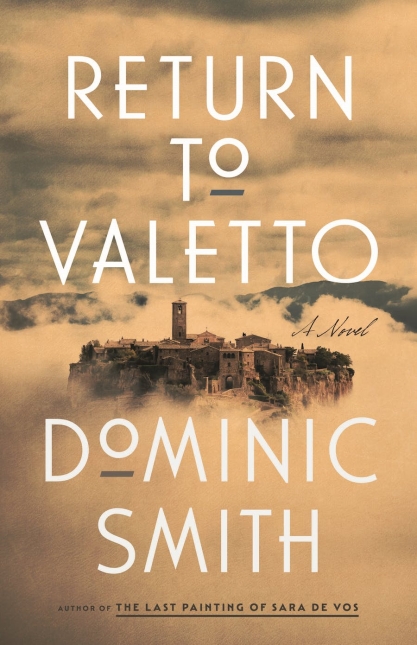Return to Valetto: A Novel
- By Dominic Smith
- Farrar, Straus and Giroux
- 336 pp.
- Reviewed by Kathryn Brown Ramsperger
- August 8, 2023
A man seeks answers about his past — and a beloved Italian village’s role in WWII.

A family reaches across a near century of betrayal, abandonment, and history to heal. But it takes a new perspective to unearth what ails them and their ancient Italian village, which is perched between annihilation and renewal.
Dominic Smith’s Return to Valetto, eagerly awaited following The Last Painting of Sara de Vos, begins in a detached observer’s voice. Narrator Hugh Fisher, an academic who documents what remains in Mediterranean towns “famous for dying,” arrives to claim his inheritance. Hugh specializes in abandonment — of late, his own. He sees buried history behind every beautiful mountaintop vista, and his family’s stone cottage on their estate overlooking Valetto is no exception.
Though he’s ostensibly here on a research sabbatical, his work proves to be more internal. He’s grieving the sudden death of his wife and is also a recent empty-nester. Full of sorrow and a longing for the past, he plans to live in the cottage he and his emotionally distant late mother, Hazel, spent their summers in but finds her old friend Alessia’s daughter, Elisa, already there. Elisa claims her family saved the life of Hugh’s grandfather Aldo, a Resistance fighter, during World War II, and that the man gave them the cottage in gratitude.
Hugh’s eccentric aunts are all aflutter about the unwelcome guest and her protests that their long-dead patriarch left the cottage to her family, particularly since they’re in the middle of planning the party of the century to celebrate Hugh’s grandmother’s 100th birthday. Moving into a wing of the villa, Hugh sets about reclaiming his inheritance. Yet what he finds as he digs through the history of Valetto and his family’s (and the village’s) actions during the war isn’t what he expected. Instead, he discovers a mystery, one to which Elisa — who possesses a stack of letters Aldo wrote from his deathbed — holds the key. Reflects Hugh:
“History is personal for me. So it’s hard to separate it from who I am. This place is in my blood...but listening to [Aldo’s] letter felt like hearing my grandfather for the first time...When I heard the letter, it was as if he was standing in the doorway. Suddenly, he seemed knowable.”
It’s also difficult to separate Hugh from his family and it from Valetto, which teeters atop a cliff and has been both victim of and witness to complex catastrophes from landslides to fascism. Equal parts cozy mystery and pilgrimage narrative, the novel initially centers on the various characters’ need to lay claim to the cottage yet expands into a story of how learning the truth about the past can heal wounds in the present.
Elisa’s mother corresponded in secret with Hugh’s mother after the women left Umbria, and Elisa brings their stories back with her, revealing shocking secrets that will touch everyone in town. As history unfurls “like the filigree of a wrought iron gate,” actions both humane and horrible come to light — actions that must be atoned for (or at least denounced) so that Hugh and his beloved Valetto can move forward.
The novel is told through Hugh’s voice — outwardly stoic and distant but inwardly sensitive, vulnerable, and slyly witty — and uses letters, texts, and characters’ recollections to flesh out what really happened during WWII. The characters are well crafted, especially Hugh’s widowed, eccentric, and opinionated aunts, who all have flower names but are hardly shrinking violets. (Aunt Iris, a sociology professor turned forensic sleuth, is particularly engaging.)
Ambitious and complex, Return to Valetto can meander, but like any gem of a book, the rewards become greater the deeper you dig. While on its face, this story is one of retribution and redemption, it’s all woven around one family’s excavation of personal grief. And despite its heavy subject matter, its subtle farce and irony keep the reader smiling. By the end of the book, the land that time eroded and forgot has hope of survival. As do Hugh and his family.
Kathryn Brown Ramsperger is a lifelong writer who has published articles in National Geographic and Kiplinger, stories in the MacGuffin and, most recently, Canada’s Nelligan Review, and two novels, The Shores of Our Souls and its standalone sequel, A Thousand Flying Things. She was a humanitarian journalist throughout Europe, southeast Africa, and the Middle East and writes about her time there in her books and whenever possible. Her work focuses on the connections we all share and how our stories can divide or heal us.

